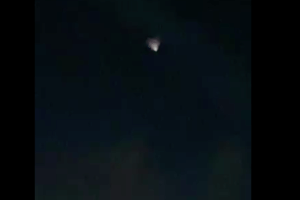
[ad_1]
Residents of several states in northeast Brazil saw, on Monday night (23), an intriguing luminous object in the sky. But there is no reason to panic: it was the Chinese space mission Chang’e-5, which had just been launched towards the moon.
The reports, photos and videos on social networks come from the cities of Ceará, Piauí, Rio Grande do Norte, Bahia, Pernambuco and Alagoas. Many people were scared by the strong light that moved slowly. Aliens? A big meteor? A modern balloon?
At the moment it passed over our country, the robotic probe was attached to the Long March-5 rocket. The spot in the sky, in the shape of a bright “steering wheel”, is a consequence of the burning of fuel from one of the stages that propelled it off Earth. “It is a curious phenomenon, called a rocket plume,” says astronomer Filipe Monteiro, a researcher at the National Observatory.
“We analyzed the launch time and the times in which the probe would cross the sky in Brazil. So we know that what was seen here, which looks like a fog in front of the object, is a reflection of the gases emitted by the burning of the fuel, during one of the rocket propulsion stages ”, he explains.
Since rocket fuel is very volatile, it is almost like sending an aerial bomb to the sky, so it is important to burn it slowly. “If something goes wrong, it explodes and the mission ends. Then this fuel discharge does not make anything explode”, says Marcelo De Cicco, astronomer and researcher at Inmetro (National Institute of Metrology, Quality and Technology). .
According to him, scenes like this will become more and more common in the coming years. “We live in a new era of space exploration, with high technological development coupled with increasingly lower costs. With more human activity in the upper Earth’s atmosphere, we will see more rockets passing by and constellations of satellites like Starlink in our sky.”
And we will also have Brazilian soil launches, when the Alcântara Space Center (CEA), in Maranhão, begins commercial activity. Takeoffs are expected from next year.
Chang’e-5
The historic Chang’e-5 mission was successfully launched from the Wenchang Satellite Launch Center on Hainan Island, China.
A Long March-5, the largest Chinese rocket, with three cylindrical cores, in the style of the SpaceX Falcon Heavy, was used to carry a robotic probe into the orbit of the Moon. The goal is to collect rock and dust samples and send them to the ground.
The last time we brought samples from our satellite was in 1976, on the Luna 24 mission, from the then Soviet Union (now Russia). If successful, China will be the third country to achieve this feat; the other is the United States, with the Apollo missions.
China will also demonstrate the potential of its space exploration technology and open doors for more complex missions, including the installation of an inhabited lunar base, around 2030.
Chang’e-5 will last 23 days and will return to Earth in late December. The return capsule will fall into the Mongolia region, bringing up 2 kg of samples from the Moon.